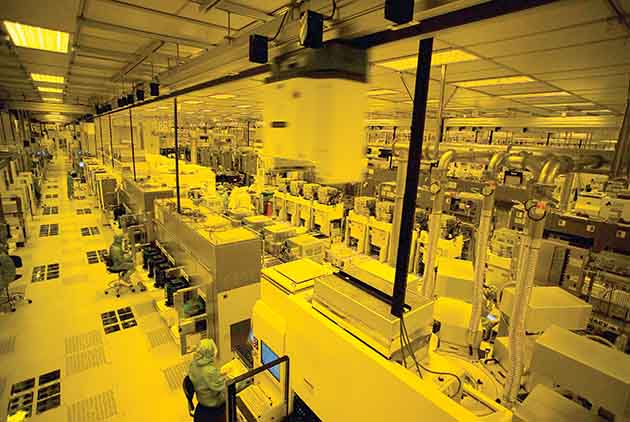Closing in on Industry 4.0
Unveiling TSMC’s Secret Weapon

Source:Kuo-Tai Liu
Recognized as one of Taiwan’s leading practitioners of Industry 4.0, TSMC has been able to maintain its pricing power in an age of plummeting component prices. What has been its secret weapon in achieving that?
Views
Unveiling TSMC’s Secret Weapon
By Monique HouFrom CommonWealth Magazine (vol. 624 )
“TSMC describes itself as Industry 3.8. They’re actually being modest,” says Nick Yeh, the chairman of Gallant Precision Machining Co. (GPM), which supplies intelligent automation systems and counts the world’s largest pure-play wafer foundry among its customers.
“Their 12-inch wafer factory is at the point where there’s nobody inside anymore,” Yeh says.
“The key to Industry 4.0 is the decision optimization behind the data.”
But in fact, TSMC’s real strength isn’t its completely automated, “lights out” factory but rather its “superhuman” digital brain decision-making system, compared by many in Taiwan’s media to a mysterious military intelligence operation.
Chien Chen-fu, a professor at National Tsing Hua University who helped TSMC develop this digital brain and smart manufacturing system symbolic of the Industry 4.0 revolution, explains that “the key to Industry 4.0 is the decision optimization behind the data.”
In an interview with CommonWealth Magazine in October 2016, TSMC Chairman Morris Chang displayed the three numbers he feels are the most important indicators of the business. One of them is the average selling price of 12-inch wafers, “which only a few people know,” Chang said at the time.
What was surprising is that half the line charting the unit price since 2007 moved upward. In other words, in an age dominated by pricing competition, TSMC has still been able to steadily raise prices. When asked how TSMC has done it, Chang answered: “that, I’m not going to tell you.”
A Secret Weapon Honed over 10 Years
Big Data Analysis Informing Decisions
A source familiar with the details acknowledges, however, that there is only one reason, aside from its technological advantage over its rivals, for TSMC to have so much pricing power – the digital brain (the so-called military intelligence operation) the company took 10 years to build is now paying dividends.
This digital brain enables TSMC to make short, medium and long-term projections for the semiconductor market, plan for that demand, and make decisions on production allocation, R&D and capital expenditures. The result is a TSMC that moves in step with the market, often leaving it as the only supplier many customers can choose from when they have to place an order.
“A very important function of this digital brain is demand planning,” the source says.
“Over the past 10 years, the business systems developed by TSMC have enabled different units responsible for different tasks, such as pricing, production and materials, to set prices, plan production, do simulations and analysis, make adjustments and set short, medium and long-term plans in one integrated platform. That ensures that TSMC can hit every one of its targets,” says a TSMC IT manager.
The Digital Brain’s Heavy Responsibility
Using IT to Avoid Human Risks
In planning for demand, for example, customer commitments and business projections can often be inaccurate, but those variations between estimates and actual orders represent the biggest risk to TSMC. Mitigating that risk is one of the digital brain’s biggest responsibilities.
“When [TSMC] looks at different customers’ products, it asks how hard they are to make and what kind of quantity they involve. A customer can promise a big quantity, but it may not turn into orders because the customer’s business changed or didn’t do well. Or maybe there are two competitors who both project big quantities. Which one do I believe? All of these variables affect planning at the time and the eventual result. So you need a systematic way to try to mitigate this kind of risk,” according to the source.
“This involves a lot of knowledge that was previously spread out across different departments. Now, we have digitized and integrated this knowledge into an analysis and decision-making system. That way we can track things and figure where the problem was if plans turn out to be inaccurate,” the source adds.
In weighing whether or not to accept an order, for example, every order has an opportunity cost. Some customers buying a product with a lower margin may want to increase their requirements, “but if I satisfy them, I may lose other business opportunities with higher margins in the pipeline. If I decide not to accept their orders, those higher margin orders may not materialize. So all of these factors are taken into account by the decision-making system, and it generates one or more near-optimum solutions. It’s then up to people to make a key business judgment and choose one,” the source says.
“In using this method to hedge against risk, we make the best possible use of our resources. Whether a company makes money or not usually depends on the quality of its decision-making.”
That TSMC has been able to maintain high yields, profit margins and capacity utilization rates has not been a matter of luck but the result of its digital brain crunchingmany variables and conducting contingency analysis.
And with the help of artificial intelligence and machine learning, the system is constantly getting “smarter” by simulating, analyzing and adjusting scenarios, bad news for TSMC’s rivals hoping to find a crack in the company’s unquestioned dominance in the semiconductor foundry field.
Translated from the Chinese article by Luke Sabatier







